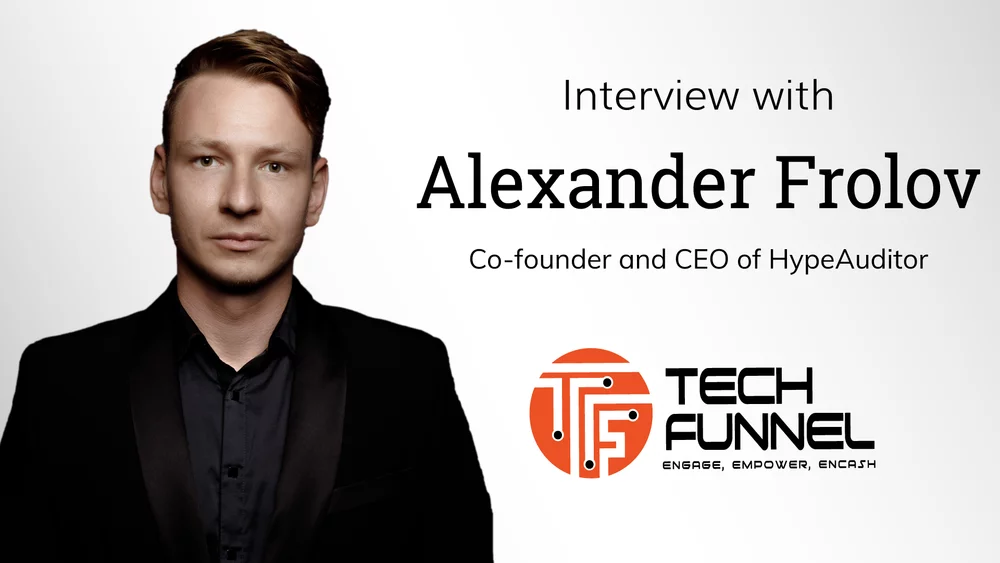With Influencer Marketing becoming an important part of the marketing mix, marketers are looking for more direction to help them choose who to pick and how to leverage their reach. We jumped in conversation with HypeAuditor’s CEO and co-founder Alex Frolov to discuss the dynamic state of influencer marketing and its trends for 2021.
- With such a big difference between the influencer landscape on Tik-Tok and Instagram, what should companies look out for when making decisions on the right platforms and influencers to use in their campaigns?
AF – A key success factor when choosing platforms for your influencer marketing campaigns is a clear understanding of your target audience. Once you understand who your target audience is, choosing the right platform becomes easier. Our latest research shows that 43% of global Instagram users are between 25 and 34 years-old and more than half of TikTok users (69%) are under the age of 24 with 39% between 18 and 24, which makes people of this age the largest user group. Accordingly, if you need a younger audience, then you can safely go to TikTok; if you need a more mature audience of Millennials, then Instagram is your best choice.
- Out of all influencer categories possible, which category do you think offers the highest ROI for companies?
AF – Most of the campaigns are in the beauty and fashion categories. We believe that these categories give the highest ROI.
- Despite finance influencers seeing the largest growth, it still wasn’t a trending topic on any major platforms. Any insights as to why that might be the case?
AF – A trending topic on platforms such as Instagram or TikTok can become entertaining, easy-to-consume content. Finance is a more complex and specific topic; it is difficult to fully disclose it in a short, one-minute video. Although there are influencers who manage to present it in a fun and simple way, there aren’t many of them. Here, rather, the question is precisely in the interests of the platform’s audience and restrictions on the forms of content presentation.
- With COVID-19, social platforms saw some of the highest traction and became extremely lucrative. However, the troll and fraud population grew as well. How do companies factor these in while creating a social marketing strategy?
AF – To avoid fraud, you need to check the influencers individually. In order to avoid losing money, you need to make your choice based on the data. Companies check accounts more thoroughly using special technologies for influencer marketing. Understand which metrics to pay more attention to when choosing an influencer. They conduct analytics of the past campaigns and continue to cooperate with the creators who have shown the best results.
- In what ways do you think brands will start to shift ad spend to influencer marketing?
AF – Influencer Marketing Hub’s survey shows that 63% of marketers intend to increase their influencer marketing budget in 2021. Influencers and their packages are easier to identify, and pricing is more transparent than it used to be. There is more expertise on what works, and how to leverage an influencer’s assets.
- In your report, you note that performance based influencer marketing is the future? How will that aspect of marketing continue to grow?
AF – Big brands now have a much clearer idea of how their money works in the influencer market, and performance-based influencer marketing is our future. Influencer marketing budgets will see a significant increase when more companies focus on individual performance and ROI of influencers. Companies are starting to rely more on the analytics of the conducted companies. The accumulated experience of what kind of influencers and what kind of content provides the best result.
- What are some ways that companies can track the effectiveness of influencer marketing?
AF – It depends on the goals of the influencer marketing campaign. The main goals include:- Increased brand awareness and recognition
- Lead generation and sales
- Grow social presence
- Collaborative content creation
If the goal is brand awareness, then a good metric for evaluating the results can be the reach of the campaign and the number of engagement (likes, comments). If a company wants to increase sales, then the company can track sales using individual promo codes for each influencer.
In the case of content creation, the metric can be the cost of a piece of content. Companies can use metrics that are key to their business. In the article, Inside Google Marketing: How we (finally) proved the value of influencer marketing, Google shared that to determine the success of an influencer marketing campaign, and they focus on brand lift to isolate impact.
Brand Interest Lift allows advertisers to measure consumer search behavior resulting from viewing the creator’s video. Influencer Lift has allowed Google to frame sponsored videos with surveys, isolating the impact and tying it back to brand goals without requiring a standard brand lift survey attached to a media buy. It tracks the difference in survey responses from viewers of a branded content video against a control group that didn’t see the video to determine the influence the branded content campaign had on key metrics, such as recall, awareness, and consideration.
- As HypeAuditor focuses purely on analytics for social media growth, what do you think are the most important metrics to look at when picking influencers?
AF – Top 5 social media influencer metrics to focus on when picking influencers- Influencer audience. The better you understand your target audience, the easier it will be for you to find the right influencers. Influencer audience is the key metric to ensure influencer campaign success. Gender, age, interests, country, language, favorite movies, books, music, who is the authority for your target audience — all that matters. For your influencer marketing campaign, you should find influencers that meet your target audience criteria.
- Engagement Rate. Engagement rate is the percentage of followers who are engaged with the influencer’s content. The more engaged the audience, the more likely they are to interact with any paid or partnership placements for your brand. But you should be aware that two out of the five comments/likes that you see on each Instagram post are made by “bot” programs. So, you should check not only the numbers of engagement, but also the quality and authenticity of comments and likes under influencers’ posts.
- Post Frequency and Advertising Post Frequency. Make sure that the influencer has regular posts. If the influencer didn’t post for more than 30 days, then this can reduce the reach and Engagement Rate of his new posts. Make sure the influencer doesn’t advertise too often. If the influencer has more than 50% of the content that is advertising in his feed, then it is better to avoid these influencers.
- Influencer’s Audience Quality. This metric shows the size of quality audience, which consists of real people and influencers, excluding mass followers and suspicious accounts. You should always check the quality of the influencer’s audience. If there are a lot of suspicious accounts and mass followers, then it is better to avoid this influencer.
- Influencer’s Campaign KPI. If you treat influencer marketing as an ongoing process and not just one-time promotions, then you should set and track KPI’s for each influencer. These can be conversions, reach, ER, comment sentiment, and the number of comments. A brand needs to build knowledge and maintain a history of its influencer marketing campaigns. It’s important to know which types of posts and influencers perform best, so you should assess the influencer’s achievement of KPIs after each campaign.
***
Alexander Frolov is co-founder and CEO of HypeAuditor, the AI analytics platform for brands seeking fair, transparent, and effective influencer marketing. He has been recognized multiple times on “The Top 50 Industry Players” by Talking Influence for his work to improve transparency within the influencer marketing industry. Follow Alex on LinkedIn and @aleksandr4bd.






